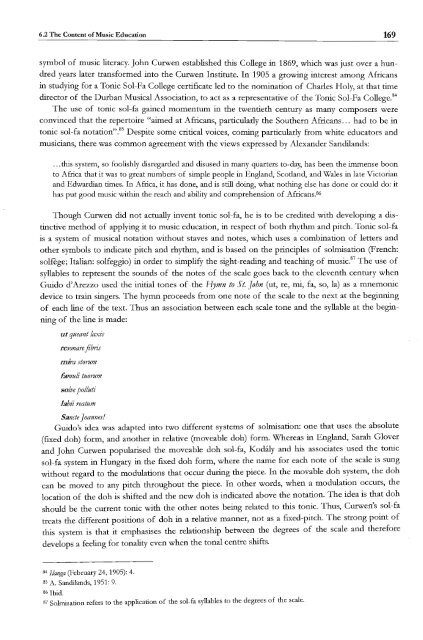South African Choral Music (Amakwaya): Song, Contest and the ...
South African Choral Music (Amakwaya): Song, Contest and the ...
South African Choral Music (Amakwaya): Song, Contest and the ...
You also want an ePaper? Increase the reach of your titles
YUMPU automatically turns print PDFs into web optimized ePapers that Google loves.
6.2 The Content of<strong>Music</strong> Education 169<br />
symbol of music literacy. John Curwen established this College in 1869, which was just over a hundred<br />
years later transformed into <strong>the</strong> Curwen Institute. In 1905 a growing interest among <strong>African</strong>s<br />
in studying for a Tonic Sol-Fa College certificate led to <strong>the</strong> nomination of Charles Holy, at that time<br />
director of <strong>the</strong> Durban <strong>Music</strong>al Association, to act as a representative of <strong>the</strong> Tonic Sol-Fa College. 84<br />
The use of tonic sol-fa gained momentum in <strong>the</strong> twentieth century as many composers were<br />
convinced that <strong>the</strong> repertoire "aimed at <strong>African</strong>s, particularly <strong>the</strong> <strong>South</strong>ern <strong>African</strong>s... had to be in<br />
tonic sol-fa notation".85 Despite some critical voices, coming particularly from white educators <strong>and</strong><br />
musicians, <strong>the</strong>re was common agreement with <strong>the</strong> views expressed by Alex<strong>and</strong>er S<strong>and</strong>il<strong>and</strong>s:<br />
...this system, so foolishly disregarded <strong>and</strong> disused in many quarters to-day, has been <strong>the</strong> immense boon<br />
to Africa that it was to great numbers of simple people in Engl<strong>and</strong>, Scotl<strong>and</strong>, <strong>and</strong> Wales in late Victorian<br />
<strong>and</strong> Edwardian times. In Africa, it has done, <strong>and</strong> is still doing, what nothing else has done or could do: it<br />
has put good music within <strong>the</strong> reach <strong>and</strong> ability <strong>and</strong> comprehension of <strong>African</strong>s. 86<br />
Though Curwen did not actually invent tonic sol-fa, he is to be credited with developing a distinctive<br />
method of applying it to music education, in respect of both rhythm <strong>and</strong> pitch. Tonic sol-fa<br />
is a system of musical notation without staves <strong>and</strong> notes, which uses a combination of letters <strong>and</strong><br />
o<strong>the</strong>r symbols to indicate pitch <strong>and</strong> rhythm, <strong>and</strong> is based on <strong>the</strong> principles of solmisation (French:<br />
solfege; Italian: solfeggio) in order to simplify <strong>the</strong> sight-reading <strong>and</strong> teaching of music. 87 The use of<br />
syllables to represent <strong>the</strong> sounds of <strong>the</strong> notes of <strong>the</strong> scale goes back to <strong>the</strong> eleventh century when<br />
Guido d'Arezzo used <strong>the</strong> initial tones of <strong>the</strong> Hymn to St. John (ut, re, mi, fa, so, la) as a mnemonic<br />
device to train singers. The hymn proceeds from one note of <strong>the</strong> scale to <strong>the</strong> next at <strong>the</strong> beginning<br />
of each line of <strong>the</strong> text. Thus an association between each scale tone <strong>and</strong> <strong>the</strong> syllable at <strong>the</strong> begin<br />
ning of <strong>the</strong> line is made:<br />
utqueant laxis<br />
resonarefibris<br />
mira storum<br />
famuli tuorum<br />
solve polluti<br />
labii reatum<br />
Sancte Joannes!<br />
Guido's idea was adapted into two different systems of solmisation: one that uses <strong>the</strong> absolute<br />
(fixed doh) form, <strong>and</strong> ano<strong>the</strong>r in relative (moveable doh) form. Whereas in Engl<strong>and</strong>, Sarah Glover<br />
<strong>and</strong> John Curwen popularised <strong>the</strong> moveable doh sol-fa, KodaIy <strong>and</strong> his associates used <strong>the</strong> tonic<br />
sol-fa system in Hungary in <strong>the</strong> fixed doh form, where <strong>the</strong> name for each note of <strong>the</strong> scale is sung<br />
without regard to <strong>the</strong> modulations that occur during <strong>the</strong> piece. In <strong>the</strong> movable doh system, <strong>the</strong> doh<br />
can be moved to any pitch throughout <strong>the</strong> piece. In o<strong>the</strong>r words, when a modulation occurs, <strong>the</strong><br />
location of <strong>the</strong> doh is shifted <strong>and</strong> <strong>the</strong> new doh is indicated above <strong>the</strong> notation. The idea is that doh<br />
should be <strong>the</strong> current tonic with <strong>the</strong> o<strong>the</strong>r notes being related to this tonic. Thus, Curwen's sol-fa<br />
treats <strong>the</strong> different positions of doh in a relative manner, not as a fixed-pitch. The strong point of<br />
this system is that it emphasises <strong>the</strong> relationship between <strong>the</strong> degrees of <strong>the</strong> scale <strong>and</strong> <strong>the</strong>refore<br />
develops a feeling for tonality even when <strong>the</strong> tonal centre shifts.<br />
84 I1anga (February 24, 1905): 4.<br />
85 A. S<strong>and</strong>il<strong>and</strong>s, 1951: 9.<br />
86 Ibid.<br />
87 Solmisation refers to <strong>the</strong> application of <strong>the</strong> sol-fa syllables to <strong>the</strong> degrees of <strong>the</strong> scale.

















